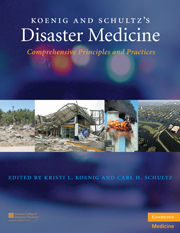Book contents
- Frontmatter
- Contents
- List of Contributors
- Contributor Biographies
- Foreword
- Preface
- Acknowledgments
- PART I CONCEPTUAL FRAMEWORK AND STRATEGIC OVERVIEW
- PART II OPERATIONAL ISSUES
- PART III CLINICAL MANAGEMENT
- SECTION A CBRNE AND HAZMAT
- SECTION B ENVIRONMENTAL EVENTS
- 32 Floods
- 33 Cyclones/Hurricanes/Typhoons
- 34 Tornadoes
- 35 Earthquakes
- 36 Tsunamis
- 37 Winter Storms
- 38 Extreme Heat Events
- 39 Volcanoes
- Index
- Plate section
- References
33 - Cyclones/Hurricanes/Typhoons
from SECTION B - ENVIRONMENTAL EVENTS
Published online by Cambridge University Press: 05 August 2011
- Frontmatter
- Contents
- List of Contributors
- Contributor Biographies
- Foreword
- Preface
- Acknowledgments
- PART I CONCEPTUAL FRAMEWORK AND STRATEGIC OVERVIEW
- PART II OPERATIONAL ISSUES
- PART III CLINICAL MANAGEMENT
- SECTION A CBRNE AND HAZMAT
- SECTION B ENVIRONMENTAL EVENTS
- 32 Floods
- 33 Cyclones/Hurricanes/Typhoons
- 34 Tornadoes
- 35 Earthquakes
- 36 Tsunamis
- 37 Winter Storms
- 38 Extreme Heat Events
- 39 Volcanoes
- Index
- Plate section
- References
Summary
OVERVIEW
Introduction
In the history of all ancient civilizations, there are fantastic tales in which a country or kingdom is saved by divine intervention. For example, when the Mongols sought to conquer Japan and complete their control of all Asia, a divine wind known as the Kamikaze saved the Japanese people from Kublai Khan by sinking the invasion fleet. This powerful storm, which saved Japan, is known today as a tropical cyclone.
Storms such as these have caused deaths in the hundreds of thousands and billions of dollars in property loss in the past 100 years on coastlines around the world. The risk seems to be increasing as more and more people decide to live in vulnerable coastal areas. As discussed in the 1999 Hangzhou Declaration in China, more than half the world's population lives in coastal areas with several of the fastest growing cities, Jakarta, Shanghai, and Miami, all projected to have 20–30 million in population by the year 2025. In the U.S., it is estimated that by 2010, 60% of the population will live on a coast. With the projected increase in number and intensity of tropical cyclones, this becomes a significant threat. The focus of this chapter is on the impact of tropical cyclones on human societies. This includes public health; the mortality and morbidity resulting from these events; intervention measures such as evacuation; medical preparedness for the affected population; and mitigation, prevention, and response strategies for the medical community drawn from a global perspective.
Keywords
- Type
- Chapter
- Information
- Koenig and Schultz's Disaster MedicineComprehensive Principles and Practices, pp. 543 - 552Publisher: Cambridge University PressPrint publication year: 2009



